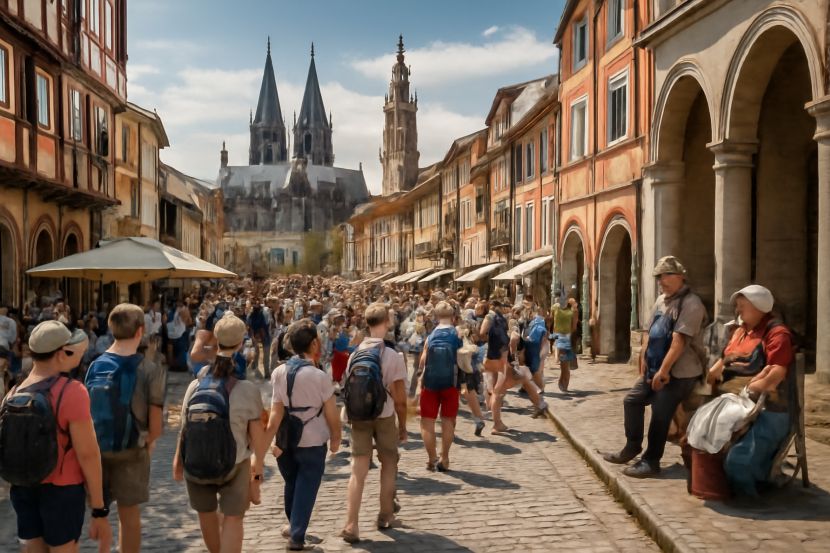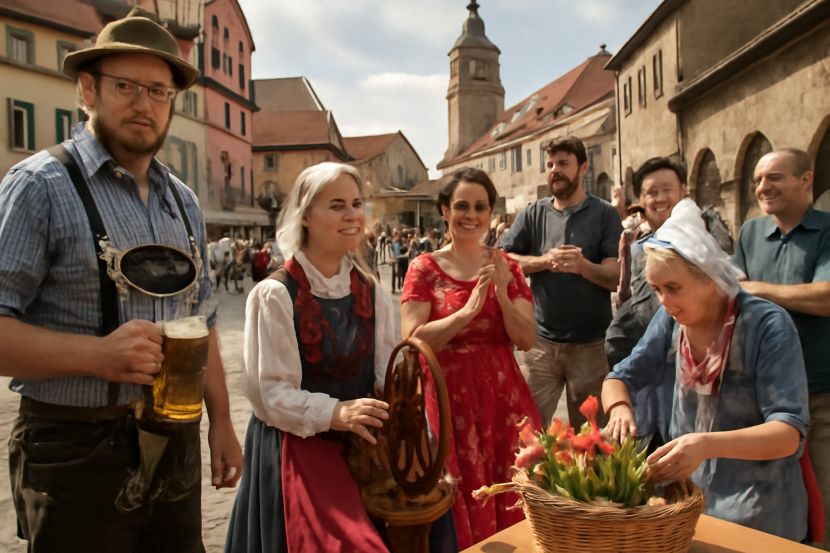Published on
November 16, 2025

Germany has now joined Spain, Norway, and the Netherlands in a groundbreaking tourism revolution. This shift is driven by a growing awareness of cultural appropriation, which threatens Europe’s very identity. As tourism continues to rise, these countries are facing a dilemma: how to protect their unique cultures while welcoming the world. Cultural appropriation in tourism occurs when aspects of a nation’s heritage are commodified or misused for profit, often without respect for their true meaning.
Germany, alongside Spain, Norway, and the Netherlands, is taking a stand to ensure that their cultural treasures are not exploited. This tourism revolution aims to preserve the authenticity of Europe’s rich cultural landscape, ensuring that visitors experience these cultures as intended by the people who have nurtured them for generations. As these nations confront the risks of appropriation, the question remains: can they protect their heritage while still embracing the global tourism boom
Germany: Tourism Boom Meets Cultural Crisis
Germany is one of the top tourist destinations in Europe. According to the German National Tourist Board, the country’s tourism is thriving in 2025. Germany’s rich history and diverse culture are key attractions. From the bustling streets of Berlin to the quiet beauty of Bavarian villages, tourists come to experience both modern and ancient German traditions.
However, with this boom in tourism comes a risk. In 2025, Germany is facing challenges with how its culture is being presented to visitors. There’s growing concern about whether tourism is using German culture respectfully or simply turning it into a product. For example, traditional German festivals like Oktoberfest or cultural landmarks such as castles and villages are being commercialized, sometimes without input from the local communities that cherish them.
The Economic Affairs Ministry of Germany has acknowledged the importance of balancing tourism with cultural integrity. In 2025, German tourism policies will likely focus on ensuring that local communities maintain control over how their culture is shared with visitors. If this balance is not found, local traditions might become hollowed-out versions of themselves, disconnected from their original meanings.
Spain: A Cultural Powerhouse Struggling with Appropriation
Spain is another country where culture is deeply woven into the fabric of its tourism industry. Known for its rich art, architecture, and cuisine, Spain attracts millions of tourists every year. However, in 2025, there are signs that cultural appropriation is increasingly present in the Spanish tourism industry.
One of the major issues is the way Spain’s diverse cultural heritage is marketed to tourists. Spain’s history includes a mix of different cultures, including Roman, Moorish, and Jewish influences. But often, these cultural elements are simplified or commodified for the sake of tourism. For instance, tourists might experience an “authentic” flamenco show, but they may not understand the deep cultural significance of the dance or its connection to Andalusian history.
In regions like Catalonia and the Basque Country, tensions have arisen around tourism’s impact on local identities. Some locals feel that their culture is being “packaged” for tourists without enough respect for its true meaning. For example, a lot of visitors come to Barcelona to see its iconic architecture, like the Sagrada Familia, but they may not know the full history behind these structures. This lack of understanding can result in misrepresentation and disrespect for the cultures that tourists are visiting.
In 2025, Spain must address these challenges by promoting a more authentic and respectful approach to cultural tourism. That means involving local communities in the tourism experience and ensuring that cultural expressions are not reduced to mere spectacles for profit.

Norway: The Beauty of Nature Meets Cultural Commodification
Norway is famous for its breathtaking landscapes, including the stunning fjords and the northern lights. Its tourism industry is heavily reliant on showcasing the country’s natural beauty, but cultural tourism is also a growing sector. In 2025, Norway faces a particular challenge: How can the country protect its culture from being exploited while sharing its rich traditions with tourists?
Norway’s indigenous Sami people are one of the key groups affected by cultural appropriation in tourism. The Sami people have a rich heritage that includes reindeer herding, traditional crafts, and unique language. However, as tourism increases in the Arctic regions, there is a growing concern that the Sami culture is being exploited. Tourism businesses offer “authentic” Sami experiences, such as reindeer sledding or visits to Sami villages, but many Sami feel that they are not involved in these experiences, and their culture is being commercialized for profit.
In 2025, Norway must consider how to ensure that indigenous communities are not exploited in the pursuit of tourism dollars. The government must work closely with the Sami people to ensure that they have control over how their culture is presented to tourists, preventing cultural appropriation from becoming a widespread issue.
The Netherlands: The Danger of Oversimplified Heritage
The Netherlands is known for its picturesque canals, historic windmills, and vibrant art scene. Tourism has long been a major contributor to the Dutch economy, with millions of visitors flocking to Amsterdam each year. However, the growing tourism industry in the Netherlands has led to concerns over cultural appropriation, especially as it relates to the representation of Dutch history.
Many tourists come to the Netherlands to experience the Dutch way of life which is often represented in simplified or stereotypical ways. For instance, Dutch cheese, clogs, and windmills are commonly used as symbols of the country’s culture. While these are part of the Dutch identity, there is a risk of reducing the country’s rich and diverse culture to a few narrow symbols.
In 2025, the Netherlands must recognize that the commodification of Dutch culture can lead to cultural appropriation. When culture is oversimplified for the sake of tourism, it loses its depth and meaning. Tourism should focus on educating visitors about the true diversity and complexity of Dutch heritage, rather than reducing it to a few stereotypical images.
Austria: A Fine Line Between Tradition and Tourist Attraction
Austria is a country steeped in history, from the grandeur of Vienna’s imperial palaces to the traditional alpine villages scattered across the countryside. Austrian culture is celebrated worldwide, and its tourism industry is a key economic driver. But in 2025, Austria is facing the same cultural appropriation challenges as many of its European counterparts.
One of the main concerns is the commercialization of Austria’s cultural heritage, particularly in tourist-heavy areas like Vienna and Hallstatt. The picturesque village of Hallstatt, for example, has become a major tourist hotspot, with visitors flocking to see its idyllic landscapes and centuries-old buildings. However, this surge in tourism has led to the commodification of the village’s culture, with local traditions being transformed into tourist attractions.
In 2025, Austria must work to preserve its cultural integrity by ensuring that tourism does not exploit its heritage. The government must take steps to involve local communities in tourism planning and ensure that they benefit from the economic opportunities tourism brings, rather than having their culture reduced to a tourist spectacle.

Why Europe’s Tourism Faces Cultural Appropriation in 2025
Several key factors are contributing to the rise of cultural appropriation in tourism across Europe in 2025. The most significant of these is the dramatic increase in global tourism. As the world recovers from the COVID-19 pandemic, more people are traveling than ever before. This has placed enormous pressure on cultural sites, landmarks, and local communities, which often struggle to balance the influx of visitors with the preservation of their heritage.
Another key factor is the increasing demand for authentic cultural experiences. Tourists often seek out experiences that make them feel like they are living the culture, but this can lead to the oversimplification or commodification of cultural traditions. In many cases, this reduces rich cultural practices to superficial experiences designed to meet tourist expectations.
Finally, there is a growing awareness of the need to respect local communities and cultures. In 2025, the European Union is increasingly focused on ensuring that tourism benefits local communities without exploiting or misrepresenting their culture.
A Call for Respectful Tourism in Europe
In 2025, cultural appropriation in tourism is a real and pressing issue in Europe. Countries like Germany, Spain, Norway, Austria, and the Netherlands are at the forefront of this challenge, as they strive to balance the economic benefits of tourism with the need to protect and respect local cultures.
As Europe continues to grow as a tourist destination, it is essential that tourism policies prioritize cultural integrity and community involvement. The future of European tourism should not be about exploiting culture for profit but about celebrating and preserving it for future generations. By making these changes, Europe can ensure that its rich cultural heritage remains intact, respected, and enjoyed by both locals and visitors alike.

